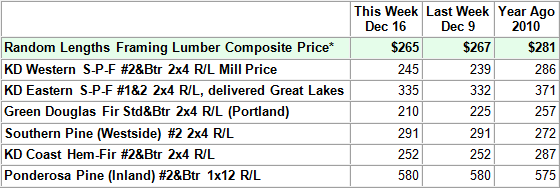I’ve long been a proponent of timber as an asset class. It’s a great way to de-risk your portfolio with a timeless asset because it’s generally uncorrelated with stocks, bonds – and it’s positively correlated with inflation.
So it’s basically the best of both worlds investment.
It’s also crushed the S&P 500 on average. According to CNBC, “From 1987 through 2007, timber delivered an average annual return of 15.8 percent…”
And today, wood prices are in a crisis. According to Dr. Jacobson of the Penn State College of Agricultural Sciences Extension, things aren’t looking so good for timber…
In his Q3 2011 report published a few weeks ago, he wrote:
“This may be the worst I’ve seen average stumpage prices since I’ve been reporting. The Southeast remains the only bright spot… The Northwest and Southwest are not only suffering from the poor economy, but the rapidly expanding natural gas industry is taking jobs and income away from the forest sector.”
Dr. Jacobson’s assertion is backed by this table showing recent lumber prices compared with prices a year ago:
Random Lengths Lumber Market Report*

Nearly every type of domestic wood is cheaper than it was a year ago. And remember, a year ago, the housing market was still in freefall.
But according to a recent report from everyone’s favorite investment bank, Goldman Sachs (NYSE: GS), the bottom for housing is finally within view.
From The Wall Street Journal story on Goldman’s report:
“Goldman’s analysts, Hui Shan and Sven Jari Stehn, project that the national S&P/Case-Shiller home price index has 2.5% to fall before it hits bottom next summer [of 2012].”
I don’t know if Goldman is exactly right, but it seems that housing is probably close to a bottom, and that regional strength in some markets will likely boost timber demand.
So that’s another bullish trend for timber and lumber prices.
How can you play this trend as an investor?
There are lots of timber REITs out there. There are a few timber ETFs and some straight timber land companies.
But I’m not a fan of most of them. The timber ETFs do a terrible job of tracking timber. Most of the REITs don’t track timber very well either – and they have the added benefit of being small and volatile.
I would suggest buying actual timber land, but that’s a tall order for most regular investors.
But your second best bet is to buy my favorite timber land company, Plum Creek Timber Company (NYSE: PCL).
Yes, it is a timber REIT, but it’s somewhat larger than most of its competitors which means it will be less volatile.
Today, you can buy Plum Creek near its 52-week lows. It currently yields an attractive 4.8% annual dividend.
If and when timber prices rebound, and the housing market hits bottom, companies like Plum Creek should benefit immensely.
For now, I’d average into this position over the coming months, and back up the truck if the stock breaches $25 a share on the downside.
 Facebook
Facebook
 Twitter
Twitter